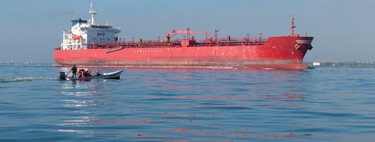A satellite image shows two ships very close together. Their origin suggests that Russia is building a fleet of LNG tankers in the shadows.
The photo. An image taken by a European Space Agency Sentinel-2 satellite shows two ships anchored side by side in the Mediterranean Sea, about 30 km northeast of Port Said, Egypt, the entrance to the Suez Canal.
According to research by TankerTrackers.comare the LNG tanker Pioneer, which is on the US blacklist, and the LNG tanker New Energy, which is not under sanctions. The former is said to be transferring Russian natural gas to the latter in order to avoid export restrictions.
Context. Before natural gas is transported, it is cooled and stored in a liquid state. It becomes liquefied natural gas, or LNG. Ships that transport LNG are known as LNG tankers; they are highly technologically sophisticated because they have to keep hundreds of thousands of liters of the hydrocarbon at a temperature of -160 degrees Celsius.
Transferring fuel between vessels is an operation known as ship-to-ship transfer (STS). It is a complex manoeuvre that requires strict adherence to safety regulations. It is therefore rare for LNG to occur in the Mediterranean.
The story. The Pioneer was blacklisted by the US Office of Foreign Assets Control (OFAC) on Friday last week. It is, along with the LNG tanker Asya Energy, which has also been sanctioned, one of the first two ships to transport natural gas from Russia’s new Arctic LNG 2 plant in western Siberia.
The LNG tanker Pioneer is operated by India-based Ocean Speedstar Solutions. The New Energy it encountered in the Mediterranean has been managed since June by a company called Plio Energy Cargo Shipping, although its ownership history suggests it is part of a ghost fleet, the company reported. Bloomberg.
The suspicions. Moscow would be developing a fleet of LNG tankers under the radar to evade US sanctions, a strategy similar to the one it uses to transport crude oil and derived products.
Once the transfer is complete, the New Energy could then travel through the Suez Canal to Asia, where it should find countries willing to buy Russian gas. It will not be easy to track, though, as energy-carrying ships often hide their location by turning off or manipulating their automatic identification systems.
Image | ESA, TankerTrackers
At Xataka | The absurd data left by the energy crisis: for the first time more gas was sent by ship than by pipeline





![[Img #74664]](https://thelatestnews.world/wp-content/uploads/2024/12/James-Watson-The-controversial-genius-behind-the-double-helix-150x150.jpg)







![[Img #74664]](https://thelatestnews.world/wp-content/uploads/2024/12/James-Watson-The-controversial-genius-behind-the-double-helix-300x200.jpg)


Add Comment